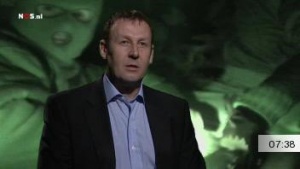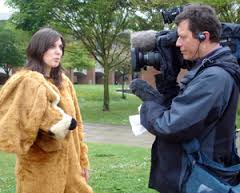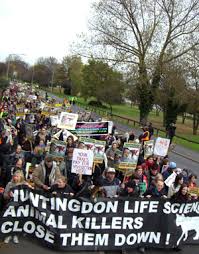Adrian Radford: Reliability of claims
This article is part of the Undercover Research Portal at Powerbase - investigating corporate and police spying on activists
This page is an annex to the proflie of Adrian Radford, a.k.a. Ian Farmer (born February 1970) who claims he was a corporate spy who has also worked for 'the governement' and for the police. Under the cover name Farmer from 1997 to 2007, he was active in gay rights groups the Equality Alliance and OutRage!, and then the animal rights campaign, Stop Huntingdon Animal Cruelty..
Most of Radford's profile is based on the two lengthy interview he has given in 2009, to Jack Grimston for The Times and to Dutch television. Subsequently, people who had known him discussed the interviews in online forums, but the information provided there is equally hard to verify.
This page discusses the reliability of the claims Radford/Farmer made in the press about infiltrating animal rights groups including Stop Huntingdon Animal Cruelty (SHAC). It also includes the article from The Sunday Times for reference.
See also:
- Adrian Radford profile.
Contents
Reliability of Radford claims
It has been hard to test the degree to which Radford's claims can be relied upon. Many of the illegal actions he claimed to have participated in have yet to be identified independently, through relevant websites such as BiteBack, which reports on actions by the Animal Liberation Front, or various other outlets.[1] Apart from that, Radford may have changed or embellished details to disguise them.
The interviews Radford has given were discussed at online forums, but most of the members do not post under their own name. Furthermore, the Dutch NOS journalist was critised for taking Radford for granted, for not checking his claims, and for presenting him as an 'undercover agent' implicating he was a police officer. In resposne, the journalist then published further statements about his research into Radford.
Mischaracterisation and mistakes

Various people at online forums have pointed out that Radford wrongly sees the Animal Liberation Front and Stop Huntingdon Animal Cruelty being one and the same organisation.[2] At one point in the interview, Radford explicitly states that SHAC is simply a front for the Animal Liberation Front and 'they are all the same organisation'.[3] A person active with SHAC who encountered Radford at the time, notes that in the interviews Radford is deliberately misleading the viewer by exclusively refering to the ALF when he should actually be naming SHAC. A particular example of Radford doing this is when he discusses his rise in the 'ALF hierarchy' of which he says:[4]
- In the ALF I was working in the back-end, looking after the office, working in an ALF cell, going actually doing the attacks, fundraising and going out and doing a large number of demonstrations and protests ... I ended up being number 3 in the UK and looking after the international operations.
The campaigner also points out that the way the ALF is presented is a gross mischaracterisation; the 'Animal Liberation Front' is label used by autonomous cells carrying out anonymous actions under a pre-existing set of principles, and as such could not amount to a formal, hierarchical organisation, let alone be as clearly defined as Radford makes it out to be. 'He may have found a particular cell to be hierarchical to the extent he claims', but it is not true of the animal liberation movement in general.[5] At one point, Radford does backtrack on there being a formal structure and modifies his claims as to the nature of the Animal Liberation Front, focusing on describing individuals as people who saw themselves as leaders, rather than them actually having that formal status.[3]
A number of other statements in the video interview are also open to challenge:
- That animal rights had never really been infilrated from the outside before:[4] notable counter examples being Bob Lambert and Matt Rayner.
- That informers and police undercovers 'could not conduct any form of criminality' and this works as a test activists can use to identify infiltrators:[4] not true as it can be authoritized by appropriate senior officers under the Regulation of Investigatory Powers Act 2000, for example. There are also numerous cases of undercovers being involved in various criminal activity, some of it of a very serious nature. Radford also contradicts himself on this (see above).
- That activists as a rule progressed from doing small, illegal actions to mass protests involving hundreds of people at airports for instance was facilitating climbing the ALF hierarchy.[4]
- The account of the rescue of the nine chickens differs considerably between the one given to The Sunday Times and the NOS video interview. In the latter it becomes an entirely different story, a much smaller operation described as essentially breaking the lock at a farm building and snatching the animals which were put in the boot of a car which then vanished into the night, not the sort of operation involving hundreds of ducks or shot-gun wielding farmers. Radford also stated its purpose was apparently to test him, to see if he 'was suitable to become an ALF member'. He made the claim that he had to plan the action and show he had the courage to carry it out in order to prove himself.[4] A further dissonance in the video interview is that it is not clear whether he had been asked to do this, or he had come up with himself in order to prove himself.
Relationship with police
Police monitoring SHAC at the time would have meant they were aware of who 'Ian Farmer' really was, indicating that at the very minimum there was some collusion by the police over Radford's infiltration.
However, following the broadcasting of the interview with Radford by the Dutch broadcaster NOS, journalist Arjan van der Horst was criticised for the way Radford had been presented, and questions were raised about the exact nature of Radford relationship with the police. The Dutch Public Prosecutor's Office told news agency ANP that Radford was not 'commissioned by the British police'; while the NOS journalist clarified that Radford was not an undercover agent per se, but rather a police informer. Van der Horst re-iterated Radford's position that having infiltrated on behalf of the lobby group GHC, he then switched to dealing exclusively with the police:[2]
- In 2004 GHC hired Radford to investigate the Animal Liberation Front's activities. Through his research Radford was aware of activities that were so serious in his eyes that he felt compelled to approach the police. After a meeting with the police it was decided that Radford would exclusively gather information for the British police. He quit his job for the government and intelligence services, trainer and also ended his contract with [GHC].
Likewise, a paragraph in The Sunday Times article made the key observation:[6]
- Under rules governing informers, Radford was strictly forbidden from committing, encouraging or initiating anything criminal without high-level police authorisation. He was also obliged to give officers any information he discovered that they could use to prevent crimes being carried out.
However, a statement from one of the Dutch journalists stated: 'Radford had permission to participate in a certain level of criminal activity'.[2]
In his Dutch TV interview, Radford speaks of scuppering actions, and reducing target lists so that particular targets could be place under police surveillance. He then states:[4]
- The whole coordinated approach to infiltrating the Animal Liberation Front was done at a very strategic level with a very large team of people behind me. It wasn't just me on my own as a spy, it was an enormous group of people, everything was planned out and very, very succinctly developed so we knew exactly what we were going to be doing and where we were going to do it.
Later in the same interview, he presents his infiltration as one of pure intelligence gathering with a view to providing the police with sufficient intelligence to target ALF activists, and that he had no role in the subsequent investigation and arrests done as Operation Achilles. And that it was Achilles which located the evidence needed for the actual convictions which subsequently happened.[4]
The statement of Arjan van der Horst also points out that his team had made efforts to establish the reliability of Radford's account, though a request for confirmation to National Extremism Tactical Coordination Unit, and to Andy Robbins of the National Domestic Extremism Team, which was in charge of investigating SHAC, who both replied identically with:
- The police receives valuable information from a variety of sources outside the police service, including from members of the community. However in these circumstances we would never confirm or deny any information allegedly provided to police officers.
Nevertheless, the Dutch broadcasters felt able to proceed on the grounds that many of the statements provided by Radford checked out, particularly with regards the animal rights movement in The Netherland and the Dutch group Respect for Animals. They also checked with the British journalist Nick Fielding who confirmed Radford as a police informant and gave him a positive reference as someone who had provided tip-offs of impending actions that had born out.[2]
The Sunday Times article
The following article was published in the The Sunday Times in 2009 and is a signficant source of material on the infiltration of animal rights groups by Adrian Radford.
Animal terrorist group foiled by informant dressed as a beagle. An undercover agent tells how he infiltrated the heart of the Animal Liberation Front to sabotage attacks and glean intelligence on its leaders
Jack Grimston, 1 March 2009
ONE November night in 2005 a Jaguar saloon carrying two animal rights activists and their getaway driver turned into an estate of executive homes in Surrey. Their target: a comfortable, mock-Tudor house behind a screen of trees. Within five minutes, the pair had wrecked three vehicles. They had also daubed abuse all over the front of the property. It was a raid like countless others carried out by the Animal Liberation Front (ALF).
On this occasion, however, the man waiting in the car was not the loyal fellow member the attackers believed him to be. He was a former soldier and intelligence services trainer who had infiltrated the ALF's tight-knit leadership and was reporting every detail of its activities to the police.
Speaking for the first time last week, Adrian Radford described his three years inside the group that terrorised scientists and suppliers linked to animal laboratories in a relentless onslaught.
Radford, who is in his late thirties, said that from 2004 to 2007 he supplied his police handlers with detailed information on hardcore extremists. Their attacks were financed with cash raised at street stalls for ostensibly peaceful animal welfare causes, he said. Radford gave detailed accounts of three attacks in which he participated. He also disclosed that he disrupted some and prevented others, often by giving the police information that allowed them to warn potential victims. One of the attacks he forestalled was against Lord Sainsbury, the former science minister. Activists intended to ambush his car near his home in Buckinghamshire, jumping out of roadside bushes firing high-pressure paint sprayers.
Radford was nicknamed "Captain Nancy" because of his flamboyant character and past work as a gay rights activist. He was widely known for the trade-mark beagle costume he wore at demonstrations. This had been supplied by the police.
In collaboration with Nick Fielding, a former Sunday Times journalist, the infiltrator is now writing a book based on his experiences.
"I have 100% sympathy with people genuinely concerned at the plight of animals," said Radford, who worked at the ALF under the name of Ian Farmer. "They were giving money for this cause and did not know the money was being used to spray-paint cars and hurl abuse at people's children."
Radford, who is now based in Gran Canaria, believes the intelligence he provided from the ALF's headquarters at a cottage in Hampshire helped the police to target its leaders and protect potential victims.
In a series of trials in recent months, four of the "godfathers" of animal extremism who were befriended by Radford have been jailed. Gregg Avery, 41, and his wife Natasha, 39, were each sentenced to nine years for conspiracy to blackmail for their part in the campaign. Heather Nicholson, Avery's former wife, was sentenced to 11 years. In a separate trial, her boyfriend Mel Broughton, 48, was convicted of fire-bombing a sports pavilion as part of a protest against an Oxford University animal research laboratory.
Radford was inside the ALF while it was in the midst of a campaign that had begun in 2001 against Huntingdon Life Sciences (HLS), a company based in Cambridgeshire that tests new medicines on animals on behalf of pharmaceutical companies. Firms across Britain and Europe with any links to HLS were targeted. In the most notorious attack, Brian Cass, the managing director of HLS, was beaten with pickaxe handles and sprayed with CS gas. Other victims had their cars blown up or received threatening e-mails. In another case, a dead woman's bones were dug up. As a result of the campaign, more than 270 businesses cut links with HLS.
As well as being leaders of the ALF, the Averys were spokesmen for Shac, the outwardly legitimate anti-HLS pressure group. Radford's infiltration suggested they were using it as a front.
The raid in which he took part on the house in Surrey in 2005 was the last target of five in what the group called its "big night". The owner was an executive at BAA, whose airports were being used for the import of laboratory animals. Radford remembers buying large quantities of paint stripper and paint at a Homebase store in Croydon, south London, incongruously paying with bags full of coins taken from an ALF stash.
As the team drove between targets, the ALF "action anthem", Sandstorm, a techno trance hit by the Finnish producer Darude, pumped from the Jaguar's stereo. The raiders wore black track-suits with torn-up black T-shirts as masks and orange washing-up gloves. Radford said the combination, as they were creeping around, "made them look strangely like blackbirds". Slogans such as "scum" were spray-painted over the house. The calling card of the ALF, the letter A inside a circle, was painted on the front door. Tyres on the three cars in front of the home were pierced with a bradawl and their paint-work wrecked. Expanding foam was sprayed into the tail-pipes to wreck their exhaust systems.
It was not the first time Radford had been engaged in conflict. His army career included work with the Intelligence Corps in Northern Ireland. After being told to leave the forces in 1994 because of his sexuality, he became involved in gay rights. He was alongside the activist Peter Tatchell during a raid on the pulpit of Canterbury Cathedral in 1998.
Radford then worked for private security firms as well as the government. In 2004, with his 20 years of experience as an intelligence field operator, he was detailed by a security firm to gather information undercover on the threat posed by animal rights extremists.
He came to know senior activists and was asked to offer his services to the police and was released from his government work to do this. The infiltrator met Natasha Avery for the first time in 2004 at an animal sanctuary convention in Kent. He decided to play up the camp side of his character - a contrast with the down-at-heel characters typical of the animal-rights movement.
Radford passed an unfriendly, greasy-bearded attendant called Max and entered the tent where senior figures were gathered. "I walked in in a pair of white chinos, walked straight over to them and said, ‘Hi, my name is Ian.' I was saying things like, ‘Oh God, this is so grungy, it's so doom and gloom'."
Gregg Avery looked dumb-founded but, said Radford, "Natasha took to me straight away". They had lunch at a stall called the Anarchist's Teapot. "She is the most lovely person - beautiful, warm, nurturing, compassionate, powerful, eloquent, charming, funny. It's just that she is also a nutcase who attacks people. Gregg was far quieter and more standoffish." His friendship with Natasha is shown by a picture of them embracing and smiling.
Radford gradually worked his way into the organisation's trust, taking part in demonstrations and manning street stalls. His first opportunity to take part in a raid came when he became aware of a plan to blow up a haulage depot at Faversham, Kent, from which trucks carried gases manufactured by BOC to the Huntingdon site. "The idea was to place multiple incendiary devices under the lorries. It would have been their worst attack ever, and it could not be allowed to happen," said Radford.
He told Natasha Avery he was determined to attack the site alone to prove himself. He then pretended to the ALF he had vandalised a vehicle owned by one of the haulier's staff. In fact, he had bought a clapped-out car and had himself filmed covering it in paint and stripper.
"This ‘proved' I could not be a covert human intelligence source," he said. "They knew police sources are not permitted to break the law."
In November 2004, Radford was allowed on another night-time raid - the liberation of hundreds of ducks from a farm in Kent. It turned into farce when the activists freed only nine chickens before being chased across fields by a shot-gun-wielding farmer. It was enough to show that Radford could be useful, and a few months later he graduated to the raid on the five houses, although he was not told of the targets in advance.
Shortly after this, Radford had an operation for a bowel tumour. Instead of pulling out of the ALF, he used this as a pretext to switch to working at the group's headquarters. It was a rented cottage occupied by the Averys and five dogs in Little Moorcote, Hampshire. Here he had access to financial and membership details. He was present at planning meetings where lists of targets were drawn up for circulation to activist cells.
Under rules governing informers, Radford was strictly forbidden from committing, encouraging or initiating anything criminal without high-level police authorisation. He was also obliged to give officers any information he discovered that they could use to prevent crimes being carried out.
He said he met his handlers at least daily, sometimes giving them dozens of documents. "I was supposed to be burning them in the lavatory, but I would burn other bits of paper instead and stuff the real ones down my front," said Radford. "If something came up in conversation, I would go to the loo and write it on my body. Later I'd pull up my shirt and show it to a handler."
The information he gleaned showed the ALF, at its peak, was receiving £750,000 a year from donations, mainly small amounts from street collections. He was also able to show that local cells of the ALF drew funding from - and often had the same leaders as - ostensibly peaceful groups such as Shac and Speak, an animal rights body in Oxford led by Broughton.
Radford's inside knowledge warned the police of targets for attack. Sometimes, he sabotaged operations, diverting blame on to others.
Often he blamed errors on Gavin Medd-Hall, 45, a computer expert whose job for the group included helping locate targets' homes. "I used to call Gavin a fat, bumbling, useless old [Please excuse my language... I'm an idiot] whenever I had sabotaged anything," said Radford.
The infiltrator was present in June 2006 when the ALF held its first international targeting meeting round a camp fire at the Kent sanctuary at 5.30am.
In January 2007, the police finally pulled Radford out to allow them to round up the group's leadership without arousing suspicion. They put him under surveillance so that it appeared to the ALF that he was compromised and being panicked into leaving.
Officers did not use his intelligence in court. They protected their sources by using it instead as leads to gather their own evidence during the investigation. Other sources confirmed Radford had passed information out of the ALF.
Attacks have fallen sharply in recent years thanks to a combination of arrests, tighter laws and court injunctions protecting HLS and other companies. "I am immensely proud. What we have done will allow people concerned about welfare to speak out without having their views tarnished by these people's actions," said Radford.
A police source said he could not confirm or deny anything to do with information allegedly passed to officers.
Timothy Lawson-Cruttenden, a lawyer who has worked for numerous clients against animal extremists, said he was glad many of the leaders were in jail. "There are just enough out of prison to keep the climate of fear going," he warned. "People have good reason to remain worried."
Resources
- Jack Grimston, ALF infiltrator speaks on UK arrests, campaign, Sunday Times (paywall), 1 March 2009. A copy can be found below.
- Arjen van der Horst, Wie is Adrian Radford, Nederlandse Omroep Stichting (NOS / a Dutch public service broadcaster), 16 March 2003.
- Rick, Did ALF-infiltrant work for the pharmaceutical industry?, AnimalLiberationFront.com, 15 March 2009. Contains links to video footage of Radfords' interview for NOS.
See also:
- Adrian Radford profile.
Notes
- ↑ Undercover Research Group: search of alternative media and mainstream media conducted June 2016.
- ↑ 2.0 2.1 2.2 2.3 Arjen van der Horst, Wie is Adrian Radford, Nederlandse Omroep Stichting (NOS / a Dutch public service broadcaster), 16 March 2003 (accessed 4 July 2016).
- ↑ 3.0 3.1 Interview with Adrian Radford, part 2, NOS, March 2009.
- ↑ 4.0 4.1 4.2 4.3 4.4 4.5 4.6 Interview with Adrian Radford, part 1, NOS, March 2009.
- ↑ Undercover Research Group: conversation with Max Gastone.
- ↑ Jack Grimston, ALF infiltrator speaks on UK arrests, campaign, The Sunday Times (paywall), 1 March 2009.




